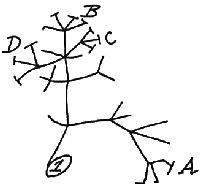Research
I currently pursue three areas of research. The first area examines the effects of eavesdropping predators and parasites on the calling dynamics of mixed frog choruses and on species divergence. The second area explores the influence of host-plant derived chemicals on anti-predator defenses in beetles, and the third area focuses on the effects of multiple mating on sexual trait evolution in beetles.
I. Eavesdropper effects on mixed frog choruses, species maintenance and diversification:
The use of conspicuous mating calls that increase attractiveness to females is ubiquitous in nature. Calling males, however, usually face a challenging tradeoff: being attractive to females also means being attractive to eavesdropping predators and parasites. This tradeoff is a major principle in the evolution of sexual signals, and studies show that calling behavior can increase risks posed by predators and parasites. Less is known, however, about the effect that calling in mixed-species choruses has on vulnerability to eavesdroppers. Given that mixed-species frog choruses are common in nature, interactions with different calling species may be an important mechanism in modulating the tradeoff between risk and mate attraction, thus shaping the evolution of sexual signals. Our lab works with two frog species that can advertise from the same ponds: túngara frogs (Engystomops pustulosus) and hourglass treefrogs (Dendropsophus ebraccatus) and who share predators and parasites: the frog-eating bat Trachops cirrhosus and blood-sucking midges in the genus Corethrella. In 2016, our lab showed that close proximity of the hourglass treefrog to túngara frogs severely increases the risks of calling. We called this “Collateral Damage”. Our current interest is to understand the mechanisms by which collateral damage happens. So our research team at Gettysburg College is involved in determining whether frogs of species that are rare within a chorus suffer increased predation and parasitism (testing the oddity effect), and in examining whether the strength of collateral damage is influenced by variation in call structure or density of nearby frogs.

Another important topic lacking in empirical investigation is the potential for eavesdroppers to influence mating signal divergence and species interactions, especially in geographic areas where closely related species come into contact. Our lab also works with a group of cryptic species closely related to túngara frogs, the Engystomops petersi species complex. We previously showed that species of this complex share the same breeding sites and hybridize in nature. We also found reduced fertilization in some but not all hybrid crosses. This finding is very exciting because the Engystomops petersi complex shares eavesdropping predators (frog-eating bats) and parasites (blood-sucking midges) with túngara frogs, and the effects of collateral damage are likely to be present in ponds hosting multiple E. petersi species. We are currently developing a project to investigate the role of sexual selection (via female choice) and ecological selection (via eavesdropper pressure) on the origin or maintenance of species barriers within the E. petersi species complex.
Collaborators:
Dr. Rachel Page (Smithsonian Tropical Research Institute)
Dr. Ximena Bernal (Purdue University)
Dr. Wouter Halfwerk (VU University)
Dr. Michael Caldwell (Gettysburg College)
Dr. Kim Hoke (Colorado State University)
Dr. Chris W. Funk (Colorado State University)
Dr. Santiago Ron (Pontificia Universidad Católica del Ecuador)
Dr. Andrea Narvaez (Escuela Politécnica Nacional del Ecuador)
II. The evolution of larval anti-predator defenses in tortoise beetles:
Our lab is also doing research that is part of a multidisciplinary, collaborative grant with Dr. Chaboo (U. Nebraska), and Dr. Keefover-Rink (U. Wisconsin), which was funded to use systematic, molecular, chemical, and behavioral techniques to characterize patterns of chemical defense evolution in tortoise beetle larva and the influence of these defense traits in lineage diversification. One of our projects compares the role of endophytes (microfungi that lives in plant tissue) on the development of larval chemical defenses of Acromis sparsa, and, Chelymorpha alternans. We are also testing predator responses to larva raised in high and low endophytic fungi environments. In another project we are comparing responses of several predators to a select group of novel larval chemical compounds found in tortoise beetles (Cassidinaes) to test whether these novel host-plant derived chemical defenses in tortoise beetles are effective against a wide or narrow range of predators.
Collaborators:
Dr. Caroline Chaboo (U. Nebraska)
Dr. Ken Keefover-Ring (U. Wisconsin)
Dr. Sunshine Van Bael (Tulane University)
PhD. Candidate Lynette Strickland (U. Illinois)


III. The effects of multiple mating on male and female sexual trait evolution in beetles:
Females in a wide range of taxa mate with multiple males. In these species, male fitness is dependent upon traits used during both pre-copulatory processes that influence mate acquisition, as well as post-copulatory processes that influence fertilization. Although more studies are starting to simultaneously examine both pre- and post-copulatory sexual selection within a single species, we still have little understanding of how these processes interact to determine reproductive success.
We found that males in Acromis sparsa beetles modulate copulatory courtship based on pre-copulatory attributes such as weapon or body size, and that in natural settings, males with longer copulatory courtship and larger testes fertilize more females and sire more offspring regardless of weapon size. These results showed that even in species with exaggerated weaponry, such as A. sparsa, under certain conditions; it is post-copulatory sexual traits that make the largest contributions to male fitness. Our lab is currently investigating developmental tradeoffs between pre-copulatory and post-copulatory morphologies in A. sparsa males, and whether these tradeoffs are influenced by larval nutrition.
Collaborators:
Dr. Patricia Gowaty (UCLA)


